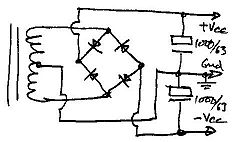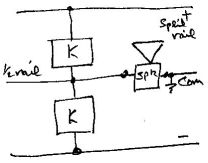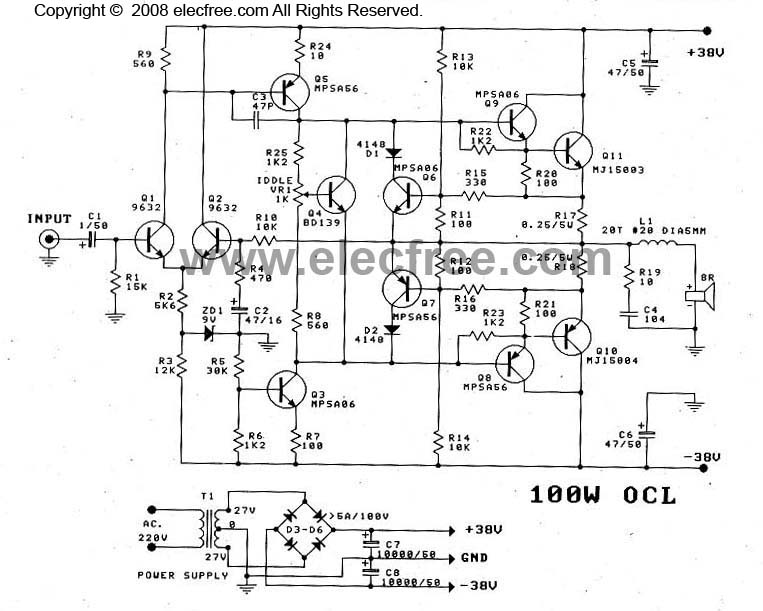Thanks Tony, that's much more like it and helps a lot.
Paolo, take a look at your (excellent, crisp, and well lit) pic 874 - a bit below the middle there are a pair of red-ish resistors connected to the yellow wires to the output pair, and marked "0.5 ohm".
These are a dead giveaway as R10 and R11 (Rod's cct above) and when you are dealing with an unknown amp you look for something like these to help orient yourself.
Another thing you look for is if the type numbers on the output transistors are the same (quasi-comp, generally both NPN as here), or different but perhaps by only one number (fully comp NPN/PNP pair, e.g. BD139/BD140, 2N2955/2N3055).
That would make the two blue wires just to the right the output transistor base connections (between the two 150 ohms brown/green/brown/gold, like R8 and R9), and the two transistors to the right will be the drivers (like Q3 and Q5 above).
A couple of variations; your amp appears to use a split rail supply and direct speaker connection rather than a single rail and output coupling cap (C5), so the supply will have a grounded mid-point between the two caps at left, just above the four diodes for the power supply bridge rectifier.


The transistor just above the centre of the pic will be doing the same anti-crossover bias and thermal compensation job as diodes D1, 2 and 3, and the transistor just to the right of that will be the VAS - Voltage Amplification Stage, Q2 above.
I'm guessing, but I'd say that the two transistors on the right-hand edge are a differential "long-tailed pair" doing a somewhat better job of the task of Q1.

Here Q1 & 2 are the long-tailed differential pair, Q4 is doing the bias/thermal comp, and in this circuit Q6 & 7 are providing overload current limiting protection (generally not used in combos where the speaker is permanently connected and not externally accessible).
It's a bit of guesswork, but it looks like your amp uses a transistor bias rather than the string of diodes, but yours doesn't appear to be adjustable, which means that it will be fairly conservatively set, and could well be the source of your "ghost fuzz" - crossover distortion. Tell me, is it worse at quieter levels than louder?
(http://www.ozvalveamps.org/repairs/solidstateamprepair.htm)
{Here endeth the guided tour of your output stage - postcards and tourist geegaws are on sale on the other side of this post.}
Paolo, take a look at your (excellent, crisp, and well lit) pic 874 - a bit below the middle there are a pair of red-ish resistors connected to the yellow wires to the output pair, and marked "0.5 ohm".
These are a dead giveaway as R10 and R11 (Rod's cct above) and when you are dealing with an unknown amp you look for something like these to help orient yourself.
Another thing you look for is if the type numbers on the output transistors are the same (quasi-comp, generally both NPN as here), or different but perhaps by only one number (fully comp NPN/PNP pair, e.g. BD139/BD140, 2N2955/2N3055).
That would make the two blue wires just to the right the output transistor base connections (between the two 150 ohms brown/green/brown/gold, like R8 and R9), and the two transistors to the right will be the drivers (like Q3 and Q5 above).
A couple of variations; your amp appears to use a split rail supply and direct speaker connection rather than a single rail and output coupling cap (C5), so the supply will have a grounded mid-point between the two caps at left, just above the four diodes for the power supply bridge rectifier.


The transistor just above the centre of the pic will be doing the same anti-crossover bias and thermal compensation job as diodes D1, 2 and 3, and the transistor just to the right of that will be the VAS - Voltage Amplification Stage, Q2 above.
I'm guessing, but I'd say that the two transistors on the right-hand edge are a differential "long-tailed pair" doing a somewhat better job of the task of Q1.

Here Q1 & 2 are the long-tailed differential pair, Q4 is doing the bias/thermal comp, and in this circuit Q6 & 7 are providing overload current limiting protection (generally not used in combos where the speaker is permanently connected and not externally accessible).
It's a bit of guesswork, but it looks like your amp uses a transistor bias rather than the string of diodes, but yours doesn't appear to be adjustable, which means that it will be fairly conservatively set, and could well be the source of your "ghost fuzz" - crossover distortion. Tell me, is it worse at quieter levels than louder?
(http://www.ozvalveamps.org/repairs/solidstateamprepair.htm)
{Here endeth the guided tour of your output stage - postcards and tourist geegaws are on sale on the other side of this post.}

 I was talking to a techno mate about this topic who pointed out that MP3 encoding makes heavy use of this subjective effect.
I was talking to a techno mate about this topic who pointed out that MP3 encoding makes heavy use of this subjective effect.


 And we're not fooled by you using dwarfs to make the bins look bigger either. :lmao: }
And we're not fooled by you using dwarfs to make the bins look bigger either. :lmao: }
